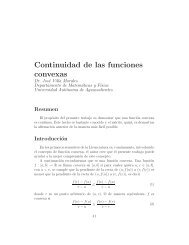Chapter 4 Linear Differential Operators
Chapter 4 Linear Differential Operators
Chapter 4 Linear Differential Operators
You also want an ePaper? Increase the reach of your titles
YUMPU automatically turns print PDFs into web optimized ePapers that Google loves.
130 CHAPTER 4. LINEAR DIFFERENTIAL OPERATORS<br />
60<br />
40<br />
20<br />
0.2 0.4 0.6 0.8 1<br />
Figure 4.2: The sum 70<br />
n=1 2 sin(nπx) sin(nπx′ ) for x ′ = 0.4. Take note of<br />
the very disparate scales on the horizontal and vertical axes.<br />
Warning: The convergence of the series <br />
n φn(x)φ ∗ n (x′ ) to δ(x − x ′ ) is<br />
neither pointwise nor in the L 2 sense. The sum tends to a limit only in the<br />
sense of a distribution — meaning that we must multiply the partial sums by<br />
a smooth test function and integrate over x before we have something that<br />
actually converges in any meaningful manner. As an illustration consider our<br />
favourite orthonormal set: φn(x) = √ 2 sin(nπx) on the interval [0, 1]. A plot<br />
of the first 70 terms in the sum<br />
∞ √ √<br />
′ ′<br />
2 sin(nπx) 2 sin(nπx ) = δ(x − x )<br />
n=1<br />
is shown in figure 4.2. The “wiggles” on both sides of the spike at x =<br />
x ′ do not decrease in amplitude as the number of terms grows. They do,<br />
however, become of higher and higher frequency. When multiplied by a<br />
smooth function and integrated, the contributions from adjacent positive and<br />
negative wiggle regions tend to cancel, and it is only after this integration<br />
that the sum tends to zero away from the spike at x = x ′ .<br />
Rayleigh-Ritz and completeness<br />
For the Schrödinger eigenvalue problem<br />
Ly = −y ′′ + q(x)y = λy, x ∈ [a, b], (4.86)




